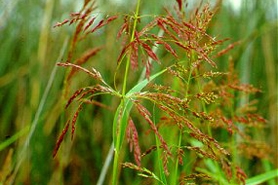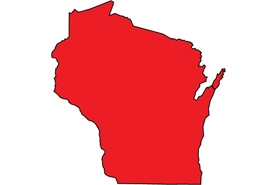Johnsongrass
(Sorghum halepense)
A warm-season perennial grass with dense rhizomes, listed as invasive in numerous states and countries.
Other names for this plant include:
- Scientific names: Andropogon controversus Steud; A. halepensis (L.) Brot.; A. halepensis var. anatherus Piper; A. miliaceus Roxb.; A. miliformis Schult.; Holcus exiguus Forssk.; H. halepensis L.; H. halepensis var. miliformis (Schult.) Hitchc.; H. sorghum var. exiguus (Forssk.) Hitchc.; Sorghum controversum (Steud.) Snowden; S. miliaceum (Roxb.) Snowden; S. miliaceum var. parvispicula Snowden
Classification in Wisconsin: Prohibited
- Ecological Threat
-
- This species is considered one of the ten worst invasive weeds in the world. Fifty-three countries, ranging in latitude from 55 N to 45 S report johnsongrass as invasive.
- Invades wetlands, floodplains, irrigation ditches, undisturbed grasslands, prairies, savannas and riparian zones.
- A prolific self-seeder, johnsongrass also spreads via an extensive rhizome system.
- Plant breeders, seed dealers and growers often observe off-type plants or "rogues" of hybrid grain sorghum. Common rogues are the tall outcrosses to sudangrass, johnsongrass or other sorghum types. Sorghum outcrosses with johnsongrass as the male parent often has rhizomes resembling those of johnsongrass. Johnsongrass-grain sorghum hybrids can become a significant weed threat.
- It contains a toxic cyanide-containing substance that can poison cattle and other livestock.
- Identification
-
Leaves & Stems: Leaves and stems (culms) are coarse. Plants can reach up to 12 feet tall when flowering.
Flowers, Fruits & Seeds: Open panicle inflorescence ranges from 4-24 inches. Spikelets occur in pairs, with up to 350 per panicle. Lemmas are ciliate usually without awns, but sometimes very short and twisted in some forms.
Roots: Rhizomatous, sometimes forming tuber-like organs. Comprises dense tangled root systems in the upper soil surface, extending deeper in loose rich soils.
- Control
- Mechanical:
- Small patches can be hand-pulled. Remove the entire root system and dispose of plant debris properly.
- For heavier infestations, mowing, tilling and burning may be effective.
- Glyphosate can be used; herbicide treatment may need to be repeated for several years to ensure effective control.
- Resources
- Sources for content:
- Johnson, B. et al. 1997. Johnsongrass control. University of Missouri Extension. Accessed 11-22-2010.
- Wisconsin State Herbarium. 2010. WISFLORA: Wisconsin Vascular Plant Species. Department of Botany, University of Wisconsin-Madison, WI 53706.
- Howard, Janet L. 2004. Sorghum halepense. In: Fire Effects Information System, [Online]. U.S. Department of Agriculture, Forest Service, Rocky Mountain Research Station, Fire Sciences Laboratory (Producer).


